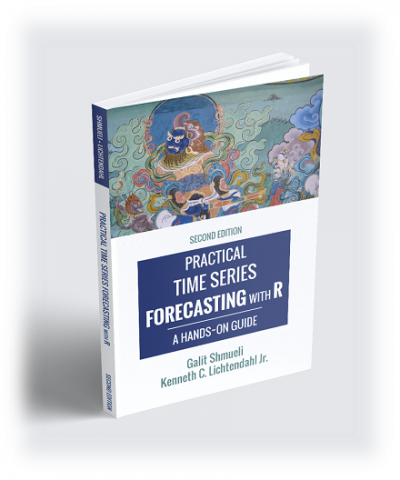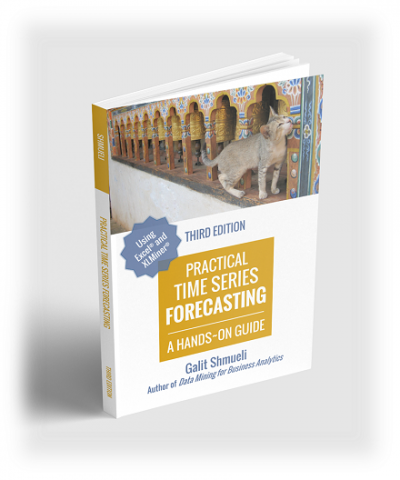Foreword by Ravi Bapna xxi
Foreword by Gareth James xxiii
Preface to the Second R Edition xxv
Acknowledgments xxix
PART I PRELIMINARIES
CHAPTER 1 Introduction 3
1.1 What Is Business Analytics? 3
1.2 What Is Machine Learning? 5
1.3 Machine Learning, AI, and Related Terms 5
1.4 Big Data 7
1.5 Data Science 8
1.6 Why Are There So Many Different Methods? 8
1.7 Terminology and Notation 9
1.8 Road Maps to This Book 11
CHAPTER 2 Overview of the Machine Learning Process 17
2.1 Introduction 17
2.2 Core Ideas in Machine Learning 18
2.3 The Steps in a Machine Learning Project 21
2.4 Preliminary Steps 23
2.5 Predictive Power and Overfitting 35
2.6 Building a Predictive Model 41
2.7 Using R for Machine Learning on a Local Machine 46
2.8 Automating Machine Learning Solutions 47
2.9 Ethical Practice in Machine Learning 52
PART II DATA EXPLORATION AND DIMENSION REDUCTION
CHAPTER 3 Data Visualization 63
3.1 Uses of Data Visualization 63
3.2 Data Examples 65
3.3 Basic Charts: Bar Charts, Line Charts, and Scatter Plots 67
3.4 Multidimensional Visualization 75
3.5 Specialized Visualizations 91
3.6 Major Visualizations and Operations, by Machine Learning Goal 97
CHAPTER 4 Dimension Reduction 101
4.1 Introduction 101
4.2 Curse of Dimensionality 102
4.3 Practical Considerations 102
4.4 Data Summaries 103
4.5 Correlation Analysis 107
4.6 Reducing the Number of Categories in Categorical Variables 109
4.7 Converting a Categorical Variable to a Numerical Variable 111
4.8 Principal Component Analysis 111
4.9 Dimension Reduction Using Regression Models 121
4.10 Dimension Reduction Using Classification and Regression Trees 121
PART III PERFORMANCE EVALUATION
CHAPTER 5 Evaluating Predictive Performance 129
5.1 Introduction 130
5.2 Evaluating Predictive Performance 130
5.3 Judging Classifier Performance 136
5.4 Judging Ranking Performance 150
5.5 Oversampling 156
PART IV PREDICTION AND CLASSIFICATION METHODS
CHAPTER 6 Multiple Linear Regression 167
6.1 Introduction 167
6.2 Explanatory vs Predictive Modeling 168
6.3 Estimating the Regression Equation and Prediction 170
6.4 Variable Selection in Linear Regression 176
CHAPTER 7 k-Nearest Neighbors (kNN) 193
7.1 The k-NN Classifier (Categorical Outcome) 193
7.2 k-NN for a Numerical Outcome 201
7.3 Advantages and Shortcomings of k-NN Algorithms 204
CHAPTER 8 The Naive Bayes Classifier 207
8.1 Introduction 207
8.2 Applying the Full (Exact) Bayesian Classifier 209
8.3 Solution: Naive Bayes 211
8.4 Advantages and Shortcomings of the Naive Bayes Classifier 220
CHAPTER 9 Classification and Regression Trees 225
9.1 Introduction 226
9.2 Classification Trees 228
9.3 Evaluating the Performance of a Classification Tree 235
9.4 Avoiding Overfitting 239
9.5 Classification Rules from Trees 247
9.6 Classification Trees for More Than Two Classes 248
9.7 Regression Trees 249
9.8 Advantages and Weaknesses of a Tree 250
9.9 Improving Prediction: Random Forests and Boosted Trees 252
CHAPTER 10 Logistic Regression 261
10.1 Introduction 261
10.2 The Logistic Regression Model 263
10.3 Example: Acceptance of Personal Loan 264
10.4 Evaluating Classification Performance 271
10.5 Variable Selection 273
10.6 Logistic Regression for Multi-Class Classification 274
10.7 Example of Complete Analysis: Predicting Delayed Flights 277
CHAPTER 11 Neural Nets 293
11.1 Introduction 293
11.2 Concept and Structure of a Neural Network 294
11.3 Fitting a Network to Data 295
11.4 Required User Input 307
11.5 Exploring the Relationship Between Predictors and Outcome 308
11.6 Deep Learning 309
11.7 Advantages and Weaknesses of Neural Networks 320
CHAPTER 12 Discriminant Analysis 325
12.1 Introduction 325
12.2 Distance of a Record from a Class 327
12.3 Fisher’s Linear Classification Functions 329
12.4 Classification Performance of Discriminant Analysis 333
12.5 Prior Probabilities 334
12.6 Unequal Misclassification Costs 334
12.7 Classifying More Than Two Classes 336
12.8 Advantages and Weaknesses 339
CHAPTER 13 Generating, Comparing, and Combining Multiple Models 345
13.1 Ensembles 346
13.2 Automated Machine Learning (AutoML) 352
13.3 Explaining Model Predictions 358
13.4 Summary 360
PART V INTERVENTION AND USER FEEDBACK
CHAPTER 14 Interventions: Experiments, Uplift Models, and Reinforcement Learning 367
14.1 A/B Testing 368
14.2 Uplift (Persuasion) Modeling 373
14.3 Reinforcement Learning 380
14.4 Summary 388
PART VI MINING RELATIONSHIPS AMONG RECORDS
CHAPTER 15 Association Rules and Collaborative Filtering 393
15.1 Association Rules 394
15.2 Collaborative Filtering 407
15.3 Summary 419
CHAPTER 16 Cluster Analysis 425
16.1 Introduction 426
16.2 Measuring Distance Between Two Records 429
16.3 Measuring Distance Between Two Clusters 434
16.4 Hierarchical (Agglomerative) Clustering 437
16.5 Non-Hierarchical Clustering: The k-Means Algorithm 444
PART VII FORECASTING TIME SERIES
CHAPTER 17 Handling Time Series 455
17.1 Introduction 455
17.2 Descriptive vs Predictive Modeling 457
17.3 Popular Forecasting Methods in Business 457
17.4 Time Series Components 458
17.5 Data Partitioning and Performance Evaluation 463
CHAPTER 18 Regression-Based Forecasting 469
18.1 A Model with Trend 469
18.2 A Model with Seasonality 476
18.3 A Model with Trend and Seasonality 478
18.4 Autocorrelation and ARIMA Models 479
CHAPTER 19 Smoothing and Deep Learning Methods for Forecasting 499
19.1 Smoothing Methods: Introduction 500
19.2 Moving Average 500
19.3 Simple Exponential Smoothing 505
19.4 Advanced Exponential Smoothing 507
19.5 Deep Learning for Forecasting 511
PART VIII DATA ANALYTICS
CHAPTER 20 Social Network Analytics 527
20.1 Introduction 527
20.2 Directed vs Undirected Networks 529
20.3 Visualizing and Analyzing Networks 530
20.4 Social Data Metrics and Taxonomy 534
20.5 Using Network Metrics in Prediction and Classification 538
20.6 Collecting Social Network Data with R 545
20.7 Advantages and Disadvantages 545
CHAPTER 21 Text Mining 549
21.1 Introduction 549
21.2 The Tabular Representation of Text 550
21.3 Bag-of-Words vs Meaning Extraction at Document Level 551
21.4 Preprocessing the Text 552
21.5 Implementing Machine Learning Methods 560
21.6 Example: Online Discussions on Autos and Electronics 560
21.7 Example: Sentiment Analysis of Movie Reviews 564
21.8 Summary 568
CHAPTER 22 Responsible Data Science 573
22.1 Introduction 573
22.2 Unintentional Harm 574
22.3 Legal Considerations 576
22.4 Principles of Responsible Data Science 577
22.5 A Responsible Data Science Framework 580
22.6 Documentation Tools 584
22.7 Example: Applying the RDS Framework to the COMPAS Example 588
22.8 Summary 598
PART IX CASES
CHAPTER 23 Cases 603
23.1 Charles Book Club 603
23.2 German Credit 610
23.3 Tayko Software Cataloger 615
23.4 Political Persuasion 619
23.5 Taxi Cancellations 623
23.6 Segmenting Consumers of Bath Soap 625
23.7 Direct-Mail Fundraising 629
23.8 Catalog Cross-Selling 632
23.9 Time Series Case: Forecasting Public Transportation Demand 634
23.10 Loan Approval 636
Index 649

